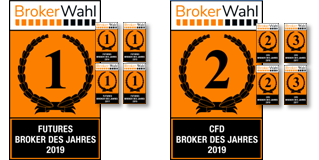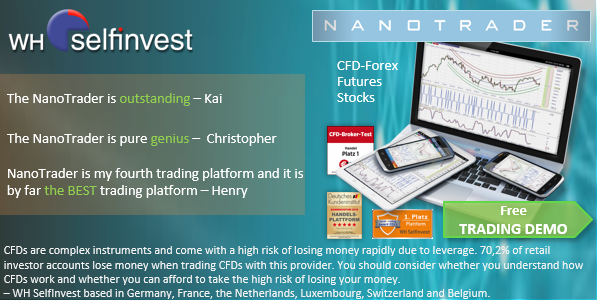
In the "Key concepts" section, we explain the basic concepts of trading that are necessary, above all, for understanding our strategy articles. The aim is to introduce beginners to complex strategies and at the same time give advanced traders the opportunity to refresh their basic knowledge.
Are you looking for an outstanding futures and CFD-Forex broker?
In the annual Brokerwahl traders voted WH SelfInvest as "Nr. 1 Futures Broker" and "Nr. 2 CFD Broker". For an incredible five times in six years WH SelfInvest is considered the best futures broker, beating all competitors by a wide margin. In CFDs WHSelfInvest came only 0,1 behind this year's first-placed broker. Clients are extremely satisfied with the low commissions, outstanding order execution and the legendary service.
Test WH SelfInvest, download a free demo.
Advance Decline Line
The Advance Decline line (AD line) examines the overall market of indices and is therefore also called the Market Width Indicator. It measures the ratio of rising stocks to falling stocks. The calculation of the AD line is simple: the difference between the number of increased shares and the number of decreased shares is calculated. If there are more winners than losers, the AD number for that day is positive. If the fallen stocks are outnumbered by the increased values, the AD number for that day is negative.
A positive number is then added to the previous day's value, a negative number subtracted from it. In this way, the so-called "Advance Decline Index" with its own trend is created. For example, if there are 200 shares that have improved in price and 50 shares that have deteriorated in price, the AD number is 150; and since it is positive, it is added to the previous day's value. The AD line is often compared with the trends of other major indices to provide a reliable measure of the trend. It can thus confirm the upward or downward trend of an index if it also rises or falls. Conversely, it can also indicate a divergence if it does not move in the same direction as the respective index.
Image 1: Advance Decline Line

Bollinger Bands
The Bollinger bands can be used to determine the level of prices relative to previous values. The bands are calculated on the basis of a moving average (GD) in the default setting over 20 periods. The upper Bollinger band is calculated from the GD plus twice the standard deviation of the prices (as a measure of volatility), the lower band is calculated analogously from the GD minus twice the standard deviation. If the bands are close together, it is a period of low volatility; if they are far apart, it is a period of high volatility.
Image 2: Bollinger bands

Moving Average Convergence/Divergence (MACD)
The indicator developed by Gerald Appel and widely used in trading calculates two lines. The faster line (called the MACD line) is the difference between two exponentially smoothed moving averages based on closing prices, usually those of the last twelve and 26 days or weeks. The slower line (signal line) is usually an exponentially smoothed 9-period average of the MACD line. Most investors trade buy and sell signals resulting from the crossing of the two lines. The difference between the lines can also be displayed in the MACD histogram (Figure 4) for better visualization.
Image 4: MACD

Image 4: The MACD indicator for SAP stock is shown. The histogram shows the difference between the blue MACD line and the purple signal line. If the signal line crosses the MACD line from bottom to top, this corresponds to a buy signal (reverse for sell signal) according to the classic interpretation.
Relative Strength Index (RSI)
The Relative Strength Index (RSI) is calculated using the following formula: RSI = 100 - 100 / (1 + RS). The RSI can be used to compare the extent of price losses with the price gains of the same period. In the formula RS (relative strength) stands for the quotient of the average of the closing prices of x days/weeks with rising prices and the average of the closing prices of x days/weeks with falling prices. Usually 14 days or weeks are used as the value for x. To determine the mean value for the days/weeks with a positive price trend, the total price gains that have accrued within the 14 days/weeks on days/weeks with rising prices must be added and divided by 14. To calculate the average value for days/weeks with a negative price trend, the total price losses incurred during this period on days/weeks with falling prices must be added up and divided by 14. The relative strength is then calculated by dividing the average price gain by the average price loss. The RS is then inserted into the RSI formula.
Image 5: RSI

Image 5: Prices above the 70 mark are considered oversold at the RSI and oversold below the 30 mark.
Shoulder-head-shoulder formation
A shoulder-head-shoulder (SKS) formation consists of two shoulders, a head and the neck line connecting the two shoulders (Fig. 6). Such a formation usually occurs at the end of strong trends and can initiate a superior reversal. It is therefore considered to be a group of trend reversal formations. A SKS occurs when a stock is in an upward trend. If this overheats, a first breather occurs and the first shoulder is formed. After this consolidation phase, however, the rally really begins: Prices are approaching new highs, usually at an adventurous pace. The head is forming. Arriving at the summit, the movement suddenly seems to run out of momentum and a high is reached. The prices tumble downwards and just as fast as they had risen before. Shortly above the starting point of the whole movement, it goes up again, the prices rise one last time and now form the second shoulder. From then on it goes down. Of course, the same game can also take place in the opposite direction. In this case it comes to an inverse SKS, with which the two shoulders lie above the head.
In the SKS formation you should always observe the volume. In the first shoulder the volume still rises during the upward movement and decreases during the downward movement. The subsequent ascent to a higher top occurs with decreasing turnover (= bearish) and the turnover of the right shoulder decreases again (= bearish). The following break of the neck line also occurs with small volume. The potential of SKS can then be unfolded. In the classical literature on SKS formations, it is usually said that the minimum price target results from the distance between the head and neck line. Let us assume that the neck line of an SKS is 53 euros, as in Figure 6, and the head 57 euros. The difference between these two values is now subtracted from the neck line. This would result in a price target of 49 euros. Such target price calculations, however, should be treated with caution. Nevertheless, it can be said in general terms that it can usually be assumed that the break of the neck line in an SKS will lead to further falling prices and in an inverse SKS to further rising prices.
Image 6: SKS formation

Image 6: In July 2011, the adidas share formed an ideal SKS high with a neck line of around 53 euros.
Stochastic
The stochastic oscillator compares the last closing price of a security with the development of its price range within a specified time period. It is based on two lines. The percentage K line compares the last closing price with the price range of the last n days. In the upward trend, the closing price is in the upper range of this range and may remain there for a longer period of time. In the downtrend, the closing price is in the lower range of this range and may stay there for longer. The percent D line is a moving average of the percent K line. The scale of the indicator is between zero and 100. Values above 80 are considered overbought, where a corresponding extreme zone is marked. Values below 20 are considered oversold, where a corresponding extreme zone is also marked. In addition, we can draw the midline at 50. Stochastic values close to 100 indicate that the underlying asset is traded at the high of the period under consideration. Stochastic values close to zero indicate that the underlying is trading at the low of the time period under consideration. In addition to the extreme zones, traders can also trade the crossing of the percentage K line and the percentage D line.
Image 7: Stochastics

Image 7 shows the stochastic oscillator of the Deutsche Telekom share. According to the classic interpretation, a buy-signal is generated when the stochastic (blue line) crosses the 20 line from below to above and a sell-signal when it crosses the 80 line from above to below. In addition, the crossing of the stochastic line with the violet signal line, which represents a moving average of the stochastic, can be traded.



